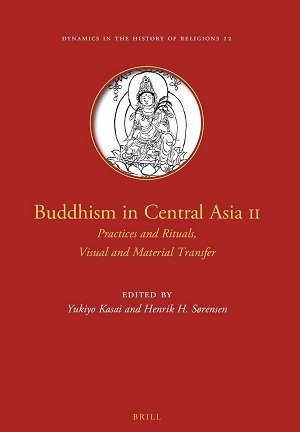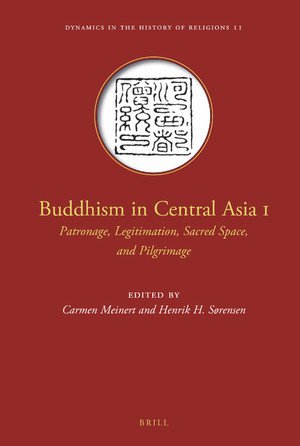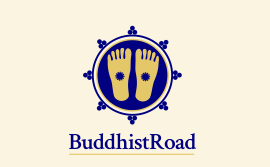书籍
Forthcoming
—BuddhistRoad Team, The Buddhist Road: Major Themes in Central Asian Buddhism, 2 vols, Leiden: Brill, forthcoming 2024/2025.
—Carmen Meinert, History of Central Asian Buddhism: Dynamics in Buddhist Networks, Leiden: Brill, forthcoming 2025.
2023
Lewis Doney, Carmen Meinert, Henrik H. Sørensen, and Yukiyo Kasai, ed. 2023. Buddhism in Central Asia III—Impacts of Non-Buddhist Influences, Doctrines. Leiden: Brill. 摘要

The present volume is based on the proceedings of the final conference “Establishing of Buddhist Nodes in Eastern Central Asia 6th to 14th C. Part III: Impacts of Non-Buddhist Influences and Doctrines” of the ERC project BuddhistRoad. The conference was organised by Lewis Doney on July 12th to 14th at Ruhr University Bochum (Germany).
We hope that this book will contribute to a new focus on the complex interactions between Buddhism and non-Buddhist traditions, and a deepening of the traditional focus on Buddhist doctrines between the 6th and 14th centuries along the Silk Roads.
Download the Volume or Selected Chapters
- Doney, Lewis, Carmen Meinert, Henrik H. Sørensen, and Yukiyo Kasai. “Introduction—The Meeting of Religious Traditions and of Beliefs in Eastern Central Asia,” 1–12.
- Biran, Michal. “Islamic Expansion into Central Asia and Muslim-Buddhist Encounters,” 13–64.
- Loukota, Diego. “Witch Women and Amorous Monkeys: Non-Buddhist Substrata in Khotanese Religion,” 65–89.
- Wilkens, Jens. “Uyghur Buddhism and the Impact of Manichaeism and Native Religion: The Case of Religious Terminology,” 90–122.
- Deeg, Max. “The Christian Communities in Tang China: Between Adaptation and Religious Self-Identity,” 123–144.
- Sørensen, Henrik H. “On the Presence and Influence of Daoism in the Buddhist Material from Dunhuang,” 145–182.
- Doney, Lewis. “Non-Buddhist Superhuman Beings in Early Tibetan Religious Literature,” 183–211.
- Berounský, Daniel. “The Fluid of Lives of Tibetan Ritual Narrations during the Imperial and Post-Imperial Period,” 212–254.
- Meinert, Carmen. “People, Places, Texts, and Topics: Another Look at the Larger Context of the Spread of Chan Buddhism in Eastern Central Asia during the Tibetan Imperial and Post-Imperial Period,” 257–295.
- Howard Masang, Meghan. “Sino-Tibetan Scholasticism: A Case Study of the Pratītyasamutpādahṛdaya in Dunhuang,” 296–349.
- Kasai, Yukiyo. “Prostration as wuti toudi 五體投地 or wulun toudi 五輪投地? A Possible Trace of Contacts between Certain Uyghur Translators and Esoteric Buddhism,” 350–372.
- Doumy, Mélodie and Sam van Schaik. “The Funerary Context of Mogao Caves 17,” 373–400.
2022
Kasai, Yukiyo and Henrik H. Sørensen, ed. 2022. Buddhism in Central Asia II—Practices and Rituals, Visual and Material Transfer. Leiden: Brill. 摘要

The present volume is based on the proceedings of the mid-project conference “Establishing of Buddhist Nodes in Eastern Central Asia 6th to 14th C. Part II: Practice and Rituals, Visual and Material Transfer” of the ERC project BuddhistRoad. The conference was organised by Henrik H. Sørensen on September 16th to 18th at Ruhr-Universität Bochum (Germany).
We hope that the book contributes to the understanding of how material culture functions in religious contexts in the form of practices and rituals such as maṇḍalas and talismans, as well as visual and material transfer, including shared iconographies and spread of 'Khotanese' themes, in religious and cultural exchange and transfer of religious knowledge in pre-modern Eastern Central Asia.
Download the Volume or Selected Chapters
- Kasai, Yukiyo, Henrik H. Sørensen, and Haoran Hou. “Introduction—Central Asia: Scared Sites and the Transmission of Religious Practices,” 1–16.
- Keyworth, George. “Did the Silk Road(s) Extend from Dunhuang, Mount Wutai, and Chang’an to Kyoto, Japan? A Reassessment Based on Material Culture from the Temple Gate Tendai Tradition of Miidera,” 17–67.
- Konczak-Nagel, Ines. “Representations of a Series of Larger Buddha Figures in the Buddhist Caves of Kuča: Reflections on Their Origin and Meaning,” 68–96.
- Lo Muzio, Ciro. “Buddhist Painting in the South of the Tarim Basin: A Chronological Conundrum,” 97–117.
- Forte, Erika. “‘Khotanese Themes’ in Dunhuang: Visual and Ideological Transfer in the 9th–11th Centuries,” 118–152.
- Russell-Smith, Lilla. “The ‘Sogdian Deities’ Twenty Years on: A Reconsideration of a Small Painting from Dunhuang,” 153–206.
- Wang, Michelle C. “Seeking the Pure Land in Tangut Art,” 207–243.
- Kasai, Yukiyo. “The Avalokiteśvara Cult in Turfan and Dunhuang in the Pre-Mongolian Period,” 244–269.
- Dalton, Jacob P. “Bridging Yoga and Mahāyoga: Samaya in Early Tantric Buddhism,” 270–287.
- Sørensen, Henrik H. “Visualising Oneself as the Cosmos: An Esoteric Buddhist Meditation Text from Dunhuang,” 288–312.
- Meinert, Carmen. “Beyond Spatial and Temporal Contingencies: Tantric Rituals in Eastern Central Asia under Tangut Rule, 11th–13th C.,” 313–365.
- Sinclair, Iain. “The Serlingpa Acala in Tibet and the Tangut Empire,” 366–399.
- Hou, Haoran. “Mahākāla Literature Unearthed from Karakhoto,” 400–429.
- Wilkens, Jens. “Practice and Rituals in Uyghur Buddhist Texts: A Preliminary Appraisal,” 430–464.
2020
Meinert, Carmen and Henrik H. Sørensen, ed., 2020. Buddhism in Central Asia I—Patronage, Legitimation, Sacred Space, and Pilgrimage. Leiden: Brill. 摘要

The present volume is based on the proceedings of the start-up conference “Establishing of Buddhist Nodes in Eastern Central Asia 6th to 14th c. Part I: Sacred Space, Pilgrimage, Patronage, Legitimation Strategies” of the ERC project BuddhistRoad. The conference was organised by Carmen Meinert and Henrik H. Sørensen on May 23rd to 25th, 2018 at Ruhr-Universität Bochum (Germany).
We hope that this book contributes to the understanding of how Buddhist patronage takes place between the three societal fields of politics, economics, and religion and thereby enables the emergence of a network of sacred sites and pilgrimage routes contributing to thoroughly transforming the multi-cultural region of Eastern Central Asia into a religious-cultural entity.
Download the Volume or Selected Chapters
- Meinert, Carmen and Henrik H. Sørensen. “Introduction—Piety, Power, and Place in Central and East Asian Buddhism,” 1–14,
- Vermeersch, Sem. “Who Is Legitimating Whom? On Justifying Buddhism’s Place in the Body Politic,” 15–39,
- Forte, Erika. “Images of Patronage in Khotan,” 40–60,
- Kasai, Yukiyo. “Uyghur Legitimation and the Role of Buddhism,” 61–90,
- Sørensen, Henrik H. “Donors and Esoteric Buddhism in Dunhuang during the Reign of the Guiyijun,” 91–122,
- Solonin, Kirill. “The Formation of Tangut Ideology: Buddhism and Confucianism,” 123–147.
- Widorn, Verena. “From Padmasambhava to Gö Tsangpa: Rethinking Religious Patronage in the Indian Himalayas between the 8th and 13th Centuries,” 151–188.
- Wilkens, Jens. “Sacred Space in Uyghur Buddhism,” 189–203.
- Raschmann, Simone-Christiane. “Pilgrims in Old Uyghur Inscriptions: A Glimpse behind Their Records,” 204–229.
- Deeg, Max. “Looking from the Periphery: Some Additional Thoughts on Yulin Cave 3,” 230–243.
- Meinert, Carmen. “Creation of Tantric Sacred Spaces in Eastern Central Asia,” 244–271.


